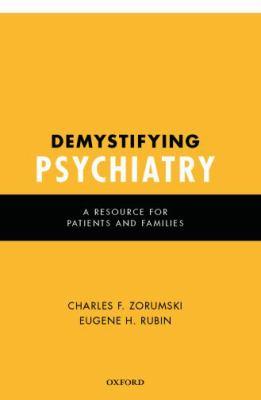After reading the last chapter of “Demystifying Psychiatry,” I felt so much better about where psychiatry might be when my kids are my age. Perhaps, if either is ever diagnosed with a mental illnesses, there will be more targeted treatments, and more optimism for a speedy recovery.
The following excerpts of “Demystifying Psychiatry: A Resource for Patients and Families” are reprinted with permission from “Demystifying Psychiatry: A Resource for Patients and Families” by Charles F. Zorumski and Eugene H. Rubin, published by Oxford University Press, Inc. © 2010, Oxford University Press.
1. Interdisciplinary Studies
Over the next 50 to 100 years, neuroscience research will lead scientists to understand in exquisite detail how humans process information, express and regulate emotions, and motivate themselves to achieve specific goals. This information will affect many clinical and scientific disciplines, including neurology, psychology, biomedical engineering, and computer sciences, but it will likely pay its greatest dividends in psychiatry. Interdisciplinary studies involving genetics, cognitive psychology, neuroimaging, and cellular and systems neuroscience offer great hope for understanding the mechanisms that contribute to psychiatric dysfunction and for finding new and innovative ways to treat mental illness.
2. Brain Plasticity
The ability of humans to learn, remember, and adapt is directly related to the changeableness (plasticity) of the human brain. Whenever we learn new information, the connections between nerve cells in the brain are modified. The activity of some connections (called synapses) increases, while the activity of other synapses decreases. The initial changes involve local chemical alterations in the way synapses transmit and receive information from other neurons. These initial chemical changes eventually lead to structural changes in the brain; that is, more connections and more complex connections form. The longer lasting of these changes require the turning on and turning off of specific genes; therefore, learning involves gene expression. Changes in synaptic connections represent a major way by which memories are formed. But as we all know, some memories fade, and it is likely that the newly formed connections must be reinforced by ongoing brain activity in order for these connections to survive. The important points to remember are that learning alters the actual structure of the brain and that genes are involved in learning.
3. Neurogenesis and Psychiatry
The story about neurogenesis (the formation of new nerve cells in the adult brain) is really part of the larger story about brain plasticity. Put another way, neurogenesis reflects the amazing resilience and plasticity of our brains. Expanding upon observations initially made years ago about birds, it has become clear that certain parts of the human brain are capable of generating new neurons throughout life, even during old age. Not all regions of the brain appear to have this ability to grow new nerve cells, but two regions, the dentate gyrus of the hippocampus and the areas near the lateral ventricles in the olfactory system (which is involved in the sense of smell), are really good at it. The dentate gyrus plays a key role in the function of the hippocampus, the region that is so critical for memory processing. It is likely that a thousand or more new neurons are born in this region each day and can be incorporated into the circuitry of the hippocampus where they help enhance certain types of learning. These new neurons may be particularly important for processing new information.
4. Biomedical Research
One of the strongest reasons we are optimistic about the future of psychiatry is the recent rate of progress in all of biomedical research. We have alluded to the major advances in genetics, molecular biology, neurobiology, and cognitive sciences that have taken place since the late 1980s. Psychiatry is especially well positioned to take advantage of these advances and to build on them. If we learned anything during the 20th century, it is that the capabilities of research involving both fundamental basic science and applied technologies have been amazing. Now, in the early 21st century, scientists have the ability to do things that were unimaginable even 30 years ago.
5. New Vistas in Diagnosis and Treatment
Today, it is easy to envision a future where psychiatric diagnosis is based on understanding fundamental defects in thinking, emotional processing, and motivational systems. In such a world, our traditional categories of psychotic disorders, mood disorders, anxiety disorders, cognitive disorders, and even personality disorders may need to be completely revised. In such a world, treatments might be much more based on underlying mechanisms, and there might be enhanced opportunities for early identification and even prevention of the disorders. In addition to the work on dementias, current research on the biology of syndromes associated with mental retardation is a great example of the potential opportunities.
* Click here to subscribe to Beyond Blue and click here to follow Therese on Twitter and click here to join Group Beyond Blue, a depression support group. Now stop clicking.

